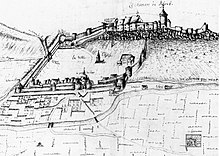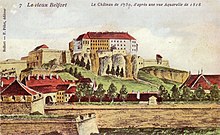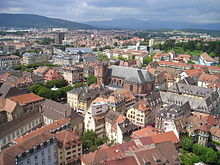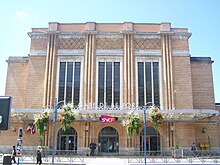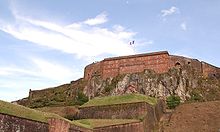Belfort
| Belfort | ||
|---|---|---|

|
|
|
| region | Bourgogne-Franche-Comté | |
| Department | Territoire de Belfort ( Prefecture ) | |
| Arrondissement | Belfort | |
| Canton | Belfort-1 , Belfort-2 , Belfort-3 | |
| Community association | Grand Belfort | |
| Coordinates | 47 ° 38 ' N , 6 ° 51' E | |
| height | 354-650 m | |
| area | 17.10 km 2 | |
| Residents | 47,656 (January 1, 2017) | |
| Population density | 2,787 inhabitants / km 2 | |
| Post Code | 90000 | |
| INSEE code | 90010 | |
| Website | http://www.ville-belfort.fr | |
Belfort (German outdated Beffert or Beffort ) is an industrial and garrison town in eastern France about 50 kilometers southwest of Mulhouse . The city is the administrative seat ( chef-lieu ) of the Territoire de Belfort and has 47,656 inhabitants (January 1, 2017).
history
Belfort was first mentioned in writing in the Peace Treaty of Grandvillars (Granweiler / Granwiller) in 1226 . Due to its location in the Burgundian Gate , the city used to be of great strategic importance. Until the Peace of Westphalia in 1648, the French-speaking Belfort belonged to the Habsburg Sundgau and the Holy Roman Empire , then to France. From 1686 the citadel of the city was expanded into a fortress by Vauban on behalf of Louis XIV. The city was walled and provided with a large number of defensive towers that are still preserved today. From December 1813 to April 1814, the fortress resisted a siege by the coalition army of Austrians , Bavarians and Russians for 113 days under Commander Legrand . In June / July 1815 General Lecourbe successfully resisted an army of 40,000 Austrians with 8,000 men.
In the Franco-Prussian War of 1870/71, the troops under Colonel Pierre Marie Philippe Aristide Denfert-Rochereau resisted a siege by Prussia for 103 days ; It was only on the express order of the French government that the fortress and town were handed over to the enemy troops on February 16, 1871, who partially razed the fortress. These successful resistance actions made Belfort and its citadel a well-known symbol of the French will to freedom and fight.
In the Peace of Frankfurt in 1871, the Territoire de Belfort , although historically part of the Sundgau and thus part of Upper Alsace , was not annexed by the German Empire like the rest of Alsace and parts of Lorraine . The former French civil servant Ferdinand Eckbrecht von Dürckheim-Montmartin , originally from Alsace, reproduces the statement made to him by the Prussian Field Marshal Count Moltke (1800-1891) after 1871 regarding the non-assignment of Belfort : “We gave up the fortress because the victor must show moderation in victory. "
The symbol of the city is the monumental lion of Belfort made of sandstone blocks by the sculptor Frédéric-Auguste Bartholdi from the years 1875/80, which commemorates the siege of 1870/71.
In the period that followed, the city, which had hitherto been in the shadow of the fortress, grew rapidly through industrialization , the suburbs ( faubourgs ) and classicist buildings on the banks of the Savoureuse emerged .
The western campaign began on May 10, 1940 , in which the Wehrmacht occupied Paris and considerable parts of France within a few weeks. The later General Walther Wenck under General Heinz Guderian was involved in the rapid conquest of Belfort - from June 18, 1940 . Wenck was promoted to lieutenant colonel for special tactical skills . At the end of 1944, Belfort was liberated by the 1st French Army .
Today the Territoire de Belfort with its capital Belfort belongs to the Bourgogne-Franche-Comté region .
Population development
| year | 1962 | 1968 | 1975 | 1982 | 1990 | 1999 | 2006 | 2017 |
| Residents | 48,070 | 53,214 | 54,615 | 51.206 | 50.125 | 50,417 | 50,863 | 47,656 |
| Sources: Cassini and INSEE | ||||||||
Culture and sights
Secular structures
The Citadel ( La Citadelle ), a fortress begun in 1687 and completed in 1703 by the builders Gaspard de la Suze , Vauban and Général Haxo , responsible for the renovation from 1817, with a privately founded art and city history museum in the barracks and viewing platform in 1872
Town hall on Place d'Armes (built in 1724 by the engineer Mareschal as a city palace for François Noblat; bought up by the Belforts in 1784; rebuilt in 1789 under Jean-Baptiste Kléber according to plans by Pierre Valentin Boudhor , remarkable staircase, hall of honor (1810) by Kléber with paintings on the history of Belfort, facade also by Kléber)
Place de la République with the Bartholdi monument of the Trois Sièges from 1913 and some striking buildings
Market hall (opened in 1905)
L'Étang des Forges (lake with circular hiking trail) with La Tour de la Miotte above , tower of a fort from 1830
Breisacher Tor ( Porte de Brisach , built by Vauban in 1687), northeast of the old town, the emblem of the Sun King Louis XIV on the front gable .
Facade painting in fresco technique, 47 famous people on an area of 403 square meters, depicted by Ernest Pignon-Ernest (* 1942)
Art museum Donation Maurice Jardot with more than 100 paintings by important artists, bequeathed by Jardot to the city of Belfort in 1997, at the same time a homage to Daniel-Henry Kahnweiler , a large art dealer whose employee Jardot was for 20 years
Maison du Peuple (People's House), constructed of reinforced concrete, inaugurated in 1933, decorated in the style of art deco
Sacred buildings
- The Cathedral Saint-Christophe de Belfort of the Diocese of Belfort-Montbéliard was in the years 1727-1752 from Vosges - sandstone built at the Place d'Armes, in the time of the French Revolution to the " Temple of Reason says" and with the establishment of the diocese Belfort-Montbéliard promoted to cathedral in 1979. Callinet redesigned her organ (1750) by Valtrin in the 19th century before it was renovated by Schwenkedel in 1966. Two paintings by Gustave Dauphin (1830 and 1843) are worth mentioning .
- Synagogue , built in 1857
- Sainte-Jeanne-Antide Church
- Church of Sainte-Jeanne-d'Arc
- Sainte-Odile Church
- Orthodox church of Sainte-Résurrection-du-Christ
- Sainte-Thérèse-de-l'Enfant-Jésus church
- Saint Joseph Church
- Saint-Louis church
- Evangelical Church of Saint-Jean
- Saint-François Chapel on rue de la Paix
- Former Notre-Dame-des-Anges church (now a grammar school)
- Sacred buildings in Belfort
Monuments
The Belfort Lion (22 meters long, 11 meters high) made of Vosges sandstone is the work of Auguste Bartholdi (1834–1904).
The monument Quand Même (1884) by Antonin Mercié on Place d'Armes depicts an Alsatian woman during the siege of 1870/71, who holds a dying soldier in her arms.
Regular events
Eastern France's largest flea market has been held in the entire old town of Belfort every first Sunday from March to December since 1966 .
The Festival international de musique universitaire has been held every year on the weekend of Pentecost since 1983 . Music groups and choirs from educational institutions from all over the world perform on numerous stages at this free festival, which takes place in the old town of Belfort.
Every year (November / December) the international film festival Entre Vue is held there. When it was founded in 1969, it was still called the Festival des jeunes auteurs de Belfort , until it was re-established in 1986.
At Lac du Malsaucy, a few kilometers northwest of Belfort, one of the largest rock music festivals in France, Les Eurockéennes de Belfort , takes place every July .
Economy and Infrastructure
The city's economy is characterized by the manufacture of power plants , mainly by the Alstom company , but parts of the production now also belong to General Electric . In addition to the electrical and electronics industry, the textile and mechanical engineering industries are represented; this is how the TGV trains are built at Alstom today . As a result of the strongly shrinking European market for power plants and the associated economic difficulties for Alstom, the number of employees on the Alstom site has decreased from 18,000 to less than 6,000 in the last ten years. This caused great economic problems in the city and the region. After 138 years, Alstom announced in September 2016 that it would close its main plant in Belfort in 2018. The decline of the plant was seen as symptomatic of the industrial decline in France. The announced closure of the traditional Alstom railway works led to a public debate in France. For example, the French Minister for Economic Affairs, Emmanuel Macron, was criticized by his predecessor Arnaud Montebourg for not being sufficiently committed to the location. Due to the symbolic importance of the location and the economic impact on the region, the French government intervened. On October 4, 2016, Prime Minister Manuel Valls announced that the Alstom plant could be saved by a state contract: The French state ordered 21 TGVs and 20 diesel locomotives.
Belfort has a train station on the Paris – Mulhouse line , which is also the junction of the Dole – Besançon – Belfort line and the (Delémont–) Delle – Belfort line . Since the LGV Rhin-Rhône went into operation , Belfort has been connected to the high-speed network with the new Belfort-Montbéliard TGV station .
Belfort-Chaux airfield is seven kilometers to the north .
Twin cities
- Delémont , Switzerland
- Leonberg , Germany
- Zaporizhia , Ukraine
- Stafford , UK
Personalities
- Amédée Willot (1755–1823), general and politician
- François-Joseph Heim (1787–1865), painter and university professor
- Gustave Dauphin (1804-1859), painter
- Jules Brunet (1838–1911), officer and general
- Paul Adolphe Kauffmann (1849–1940), painter and illustrator
- Léon Deubel (1879–1913), poet
- Jean Rapenne (1901–1952), colonial administrator
- Lucien Moraweck (1901–1973), film composer
- Étienne Mattler (1905–1986), football player
- Bernard Gantner (1928–2018), painter
- Claude Bourquard (1937-2011), fencer
- Jean-Pierre Chevènement (* 1939), politician, mayor of the city and minister
- Alain Gerber (* 1943), author and jazz critic
- Gérard Grisey (1946–1998), composer
- Marie-Noëlle Lienemann (* 1951), politician
- Jean-Luc Cappozzo (* 1954), jazz and improvisation musician
- Michel Godard (* 1960), jazz musician
- Philippe Heberlé (* 1963), marksman
- Pierre Jean Schoen (* 1967), organist
- Céline Bonacina (* 1975), jazz musician
- Philippe Bussonnet (* ≈1976), fusion musician
- Olivier Schoenfelder (* 1977), figure skater
- Tahar Rahim (born 1981), actor
- Johanne Morant (* 1986), ice hockey player
literature
- Yvette Baradel et al. a .: Histoire de Belfort . Horvath, Roanne / Le Coteau 1985
- Le Patrimoine des Communes du Territoire de Belfort. Flohic Editions, Paris 1999, ISBN 2-84234-037-X , pp. 41-91.
Web links
Individual evidence
- ^ Eckbrecht Graf Dürckheim-Montmartin: Memories of an Alsatian Patriot , Stuttgart 1922, p. 351
- ↑ on the quick conquest of Belfort see here (p. 132) : Wenck reached Montbéliard around midnight; Guderian allowed him to advance further, Belfort is about 20 km north. Guderian arrived in Belfort on the morning of June 18. The forts refused to surrender; they were surrendered by attacks on the same day
- ↑ http://next.liberation.fr/cinema/0101448584-janine-bazin-sa-vie-son-role , penultimate paragraph
- ^ Leo Klimm: Bonjour Tristesse. , Tages-Anzeiger , September 13, 2016, p. 11
- ↑ Alstom à Belfort: la fin d'une industrial adventure - France 3 Franche-Comté. Retrieved September 14, 2016 .
- ↑ Alstom - Valls: "Ce n'est pas du bidouillage, c'est de la strategy". Retrieved March 27, 2017 .

